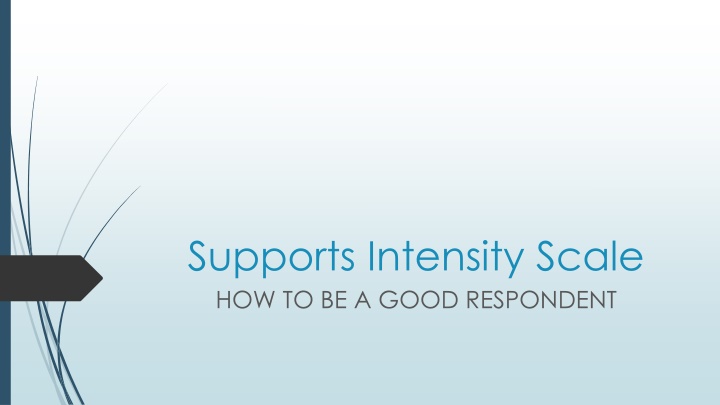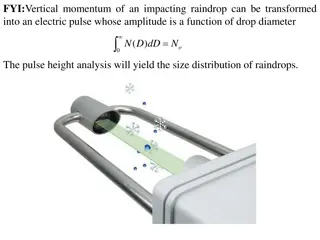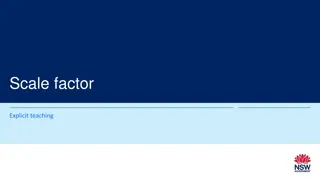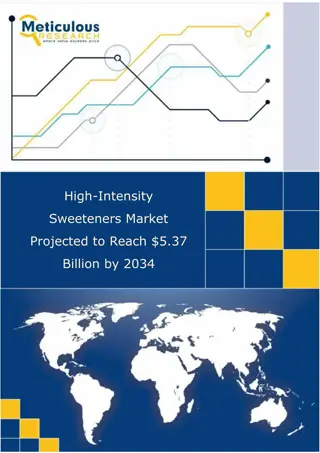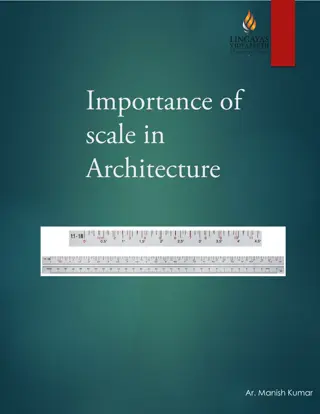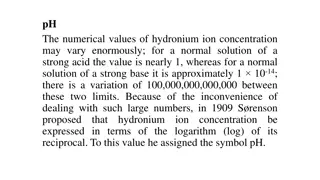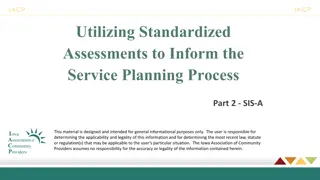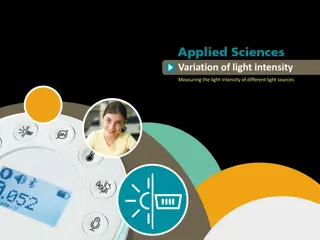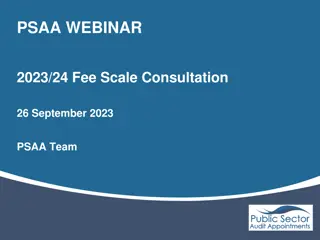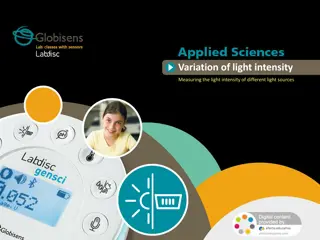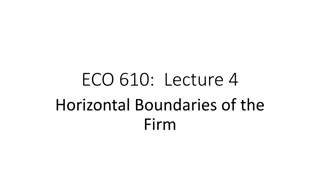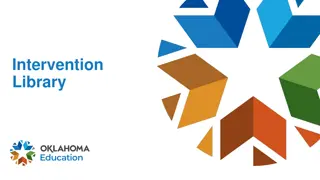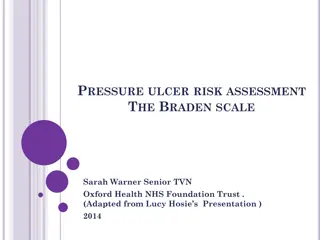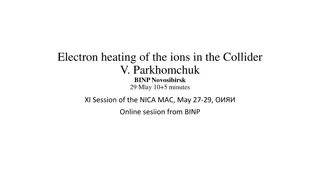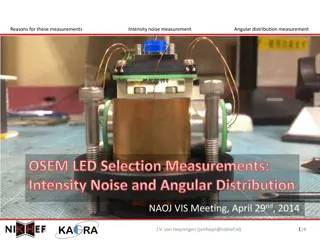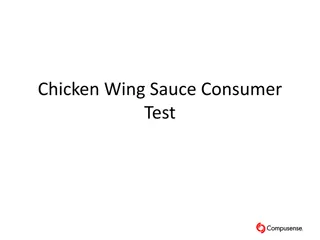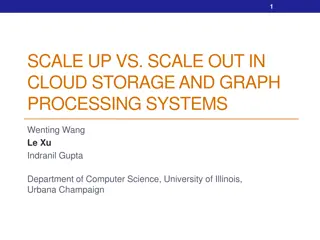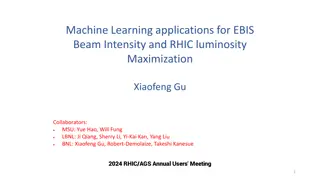Supports Intensity Scale
SIS, developed by AAIDD, assesses support needs of adults with disabilities. Learn about the scale, what supports mean, and the role of respondents in interviews.
Download Presentation

Please find below an Image/Link to download the presentation.
The content on the website is provided AS IS for your information and personal use only. It may not be sold, licensed, or shared on other websites without obtaining consent from the author.If you encounter any issues during the download, it is possible that the publisher has removed the file from their server.
You are allowed to download the files provided on this website for personal or commercial use, subject to the condition that they are used lawfully. All files are the property of their respective owners.
The content on the website is provided AS IS for your information and personal use only. It may not be sold, licensed, or shared on other websites without obtaining consent from the author.
E N D
Presentation Transcript
Supports Intensity Scale HOW TO BE A GOOD RESPONDENT
What is the SIS? SIS was developed by AAIDD (American Association of Intellectual and Developmental Disabilities) over a 5 year period in response to changes in how society views and relates to people with disabilities The Supports Intensity Scale is a standardized assessment tool, designed to measure the pattern and intensity of support an adult with developmental disabilities needs to be successful. It evaluates the pattern and intensity of needed support in 6 Life Activity Domains, in protection and advocacy activities, and in exceptional medical and behavioral support needs Normed with over 1300 people in 33 states and 2 Canadian Provinces with intellectual and developmental disabilities who had a variety of support needs Ages ranges from 16 to 72 and was culturally diverse Determined reliable and valid
What does supports mean in the Supports Intensity Scale? Supports means the assistance with individual needs to do something successfully. Success means a level of performance, involvement, and participation in an activity that is comparable to that of same age adults without disabilities. Recognizes that individual needs change over time and supports may change as well. Focuses on the positives of support as opposed to looing at someone's deficits.
What are we looking for with each question? What type of support is needed How often support is needed How much support is needed over a 24 hour period
What are Respondents and what is the purpose? People designated to answer questions about the support needs of the individual. They can be paid or unpaid people that know the person. A Primary Respondent is an individual who has known the person well for at least the last 3 months and actively provided support during that time. An interview typically includes: the individual, direct support staff from employment/day services and residential services, the support coordinator, and the Guardian or family member
What do respondents do during the interview? The interviewer will explain the interview process, ask you interview questions, and record your answers The respondents will answer all questions even if they don t seem to apply to the individual now or in the future, be ready to describe supports, be specific when describing the support needs of the individual Remember to include in your description all the supports you currently are providing for/with the individual.
What if You know any topics that may make the individual feel uncomfortable or trigger uncomfortable responses? Help the individual tell the interviewer or Tell the interviewer yourself, prior to the interview Also, the individual does not have to be present for the entire interview. You can ask that they be given a break or leave the room.
Things to know about the interview: SIS is not a test. There are no right or wrong answers It is important for respondents to give their input and be as accurate as possible Since the SIS is a standardized assessment, all the questions must be answered even if they don t seem to relate to the individual The interviewer will facilitate a conversation between respondents to settle disagreements in scoring. Respondents do not need to bring anything with them! This is about having a conversation.
Medical and Behavior Sections Rated with the issues the individual has at the time of the assessment Completed first to help the interviewer become more familiar with the person Risk Assessment may be indicated if these sections alert the interviewer. Otherwise, the Risk Assessment is a document completed by the Support Coordinator annually the years SIS are not conducted. Remember the SIS is a snapshot
Activity Domains and Life Activities There are 6 Activity Domains and 49 Life Activities: Home Living Community Living Lifelong Learning Employment Social Activities Health and Safety
The SIS offers the opportunity to record what is important TO and FOR the person Important TO the person What individuals say in their own words What individuals say with their own behavior Important FOR the person Health Safety Being a valued member of his or her community These will be addressed as Shared Outcomes in the PCP process
Ratings: Ratings are based on the support needs of the individual, and need to be reflected as accurately as possible across all settings. Ratings do not imply that each of the activities rated must be incorporated into the person s individual plan. Person Centered planning decisions will use information provided during the SIS and prioritized by the Personal Profile development completed by the person and the team. When the interview is complete, the SIS is scored by Ascend, and then released to the Support Coordinator to be distributed to the planning team.
What does this mean?? The score will be used to determine the reimbursement tier for the individual. SIS is used during the Person Centered Planning Process and can help in planning for individualized supports and services. SIS does not replace the VIDES with regards to eligibility of Waiver Services, though the information between the VIDES and SIS should be consistent. SIS can be appealed but only by the individual or family member. They are only able to appeal that the Standard Operating Procedures were not followed. They cannot appeal the scoring. Support Needs can be re-assessed before the three years if there is a significant support need change within that time.
Credits DBHDS AAIDD Deanna Rennon, Wall Residences QA Coordinator and Kim Snider, Wall Residences Regional Coordinator
